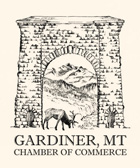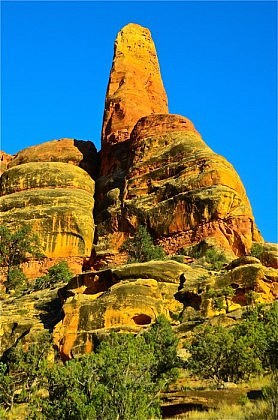It may be counter-intuitive, but dead trees are indicative of a healthy forest. Note that a forest differs from a tree-farm. A forest is diverse, usually with plenty of dead downed wood, standing snags, living trees, shrubs, grasses and forbs. Wildlife is usually abundant due to the diversity of habitats provided by the forest and its woody and leafy structures. By contrast, tree farms are impoverished, with many of the aforementioned forest features eliminated in the quest to maximize cellulose production. In a tree farm, dead or dying or twisted or multi-branching trees are a waste. That’s because in plantations trees are an economic product, not an important facet of biodiversity. To an ecologist, though, dead trees are habitat.
Our guided Yellowstone backpacking treks explore forests, not tree farms. As do our guided hiking tours elsewhere in the West, including Wyoming and Montana, Utah, New Mexico and Alaska. Because we backpack in untrammeled wild roadless country that has never been logged or heavily manipulated by industrial humans, expect to encounter dead trees. And that’s a good thing.
Standing dead trees are called “snags” and they often stand for decades before they fall. While they stand, they provide food, nesting and roosting habitat for dozens of bird species, including various owls, woodpeckers, nuthatches and more. Squirrels, marten, fisher, black bears and many other mammals also utilize snags, especially when they are partially rotted out with nesting or denning “hollows”. Snags provide shade for re-growth after a forest fire. When the snags fall, they provide cover for elk, moose, bear and many other species; and once on the ground they provide “drumming logs” for ruffed grouse and hunting routes for marten. And, as they rot, they can become a “nurse log” for tree seedlings. Rotten wood also captures and retains critical moisture in ares with dry summers, like much of the Rocky Mountain region. They recycle nutrients back into the soil. When they fall across slopes, dead trees also reduce erosion. When snags fall into streams and rivers, the dead wood forms pools which are great trout habitat. They also stabilize stream-banks and releases nutrients into the aquatic ecosystem. This is all just a general outline on the value of dead trees. I’ve barely scratched the surface. But you get the picture. Do not let a forester tell you that a forest with lots of dead trees is “unhealthy”. It is not!
In the next installment, we’ll begin to discuss safety among dead trees, because of course, eventually they do blow over and when they do, we don’t want them to land on our clients.



